Fun Facts
- The original Jungle Books is a collection of stories written by English author Rudyard Kipling while he spent years in India.
- The popular character of King Louie from the Disney iterations is a new character made specifically for the movies and is not in the original books.
- Kaa is an Indian rock python who notably mentors Mowgli in the books but is always depicted as another antagonist in movies.

Contrary to popular belief and movie tropes, tigers do not actively hunt humans and are victims of poaching and persecution.
©Anuradha Marwah/Shutterstock.com
Disney loves adapting old fables and fairy tales into beautiful animated or live-action movies the whole family can enjoy. While the movies take liberties with the source material, many of these stories come from a place of realism.
The Jungle Books is an excellent example of movie companies showcasing a popular story while tweaking the source material to fit a specific theme and style. Several animals range from slight alterations to dramatic changes to make the world feel larger and magical.
Come along and explore the real animals roaming the Seeonee jungle in The Jungle Book.
Intro to the Jungle Book
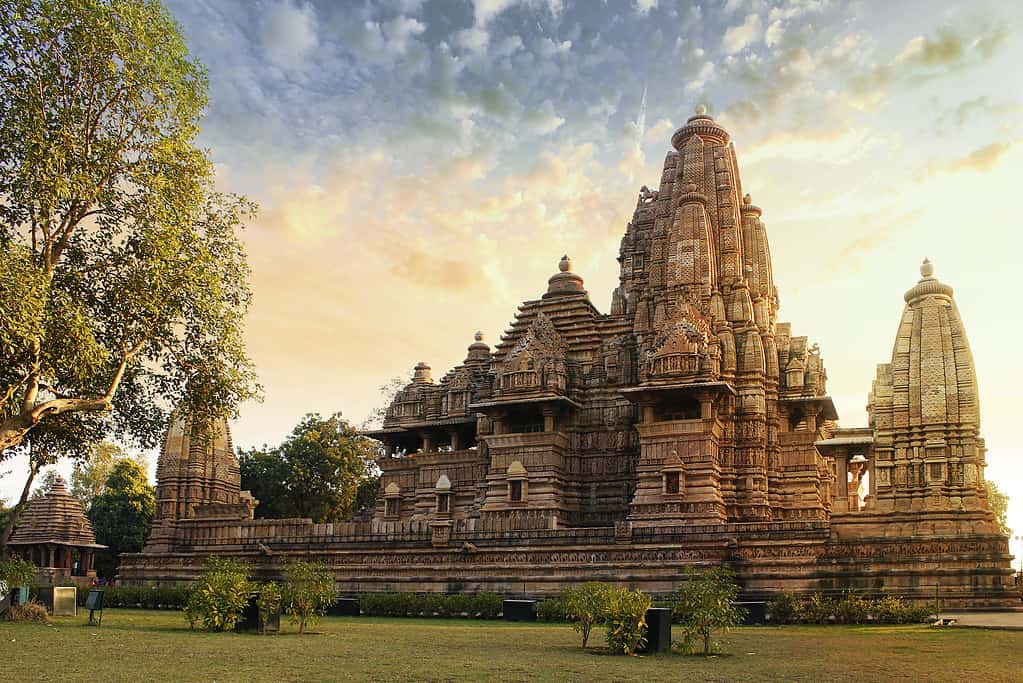
Kipling spent many years in India while working on his stories, becoming inspired by the beautiful architecture and stories shared with him.
©ShutterBug/iStock via Getty Images
Written in 1894 by English author Rudyard Kipling, “The Jungle Books” is a collection of fables and short stories about anthropomorphic animals and their connection to humanity, as well as overcoming abandonment and finding comfort in a new family.
Kipling based the fictional jungle of the Seeonee jungle on Madhya Pradesh in Central India. The stories are very popular with children because of the animal’s ability to speak, create laws, sing, and follow a hierarchy structure as guidelines to continue one’s studies and how to behave around others.
The most well-known stories are from the Disney animated movies, focusing on the short stories “Kaa’s Hunting” and “Tiger, Tiger,” narrating the events of an orphan child named Mowgli who is raised in the jungle by animals and forced to contend with several threats.
Animals from The Jungle Books
Disney and other movie studios did a decent job highlighting the types of animals from the books, but specific key details are embellished to heighten the fantasy. The real versions of these animals are just as spectacular and equally charming.
The Wolf Pack – Indian Wolves
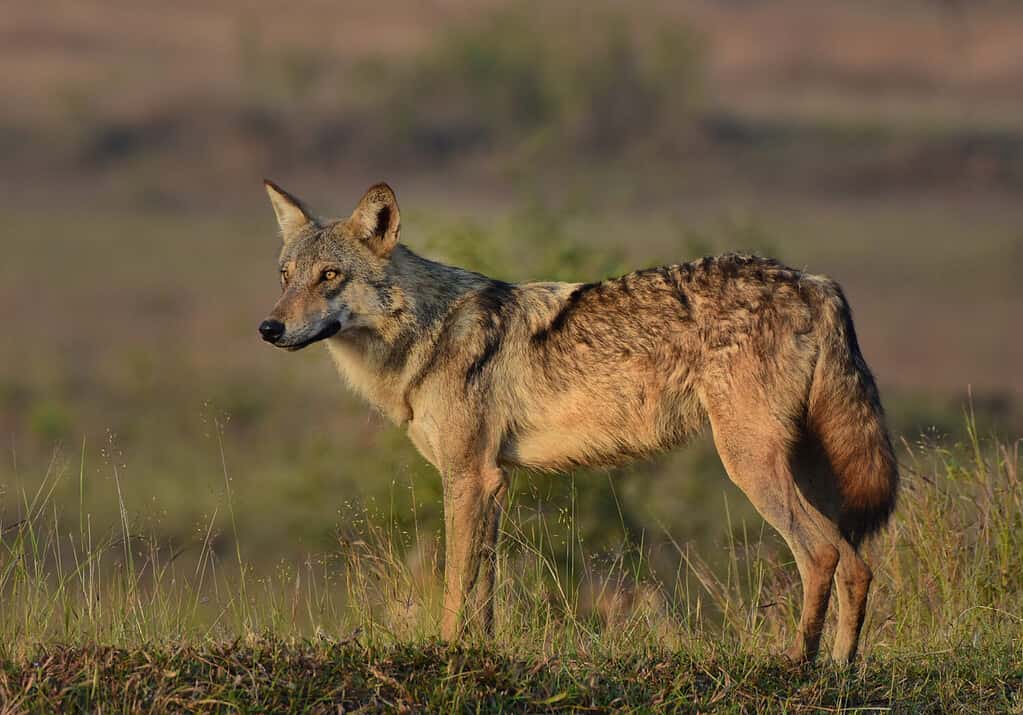
Indian gray wolves are smaller than other gray wolves but operate just as effectively in packs.
©wildlife by yusuf/Shutterstock.com
First, the wolf pack that adopted the orphan Mowgli are Indian wolves. These wolves live across Asia, India, Iran, Nepal, Israel, Turkey, and Syria. Preferring to live in grasslands and forests, they are notably smaller than their gray wolf cousins.
Indian wolves weigh 55 pounds and live between 5 to 13 years. They live in packs of six to eight members but mainly hunt rodents, hares, and raccoons individually. On occasion, Indian wolves will work together in pairs to hunt larger prey like antelope by having one serve as a distraction while the other attacks.
Families teach their children to behave or else Indian wolves will steal them away in the night.
Bagheera – Black Indian Leopard
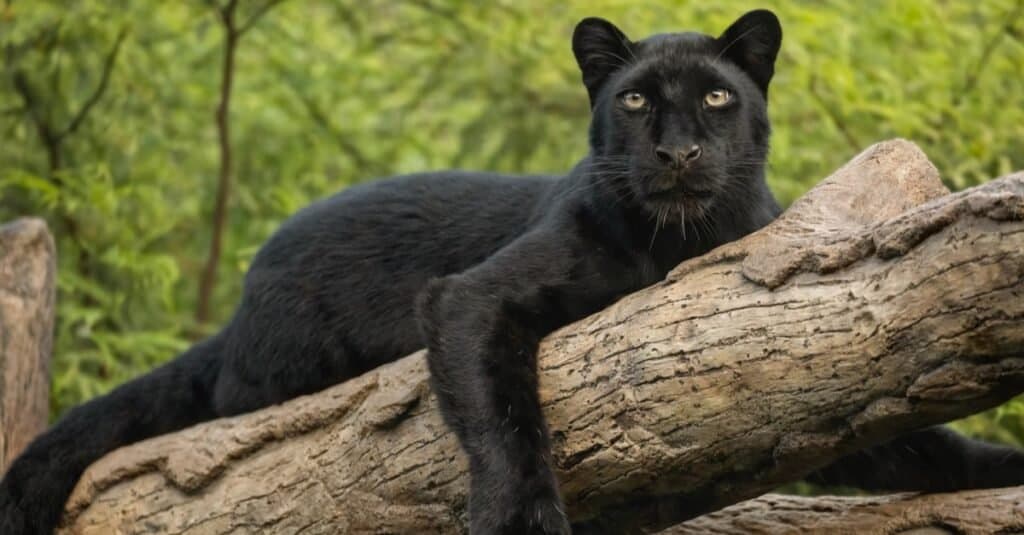
In the books, Bagheera is often seen napping in trees and being a kind and motherly figure to Mowgli.
©sergeyle le/Shutterstock.com
One of the main characters and mentors of the story is the black panther (Panthera pardus fusca), Bagheera. A popular and wise mentor, many adaptations depict Bagheera correctly with a full black coat, glowing eyes in the dark, and hints of iconic leopard spots in his coat.
Indian leopards prefer to live alone, capable of living 12-17 years in the wild, or 23 years in captivity. They are found across Asia in assorted forests and the Himalayan mountains. Similar to many leopards, they are active during dusk and dawn, while some hunt at night where their coat gives them an advantage in the darkness.
Indian leopards are opportunistic feeders, willing to eat deer, boar, langurs, hares, peafowl, and small primates if they get the chance.
Unfortunately, Indian leopards are vulnerable due to habitat loss, poaching, and persecution from conflicts involving people.
Baloo – Sloth Bear
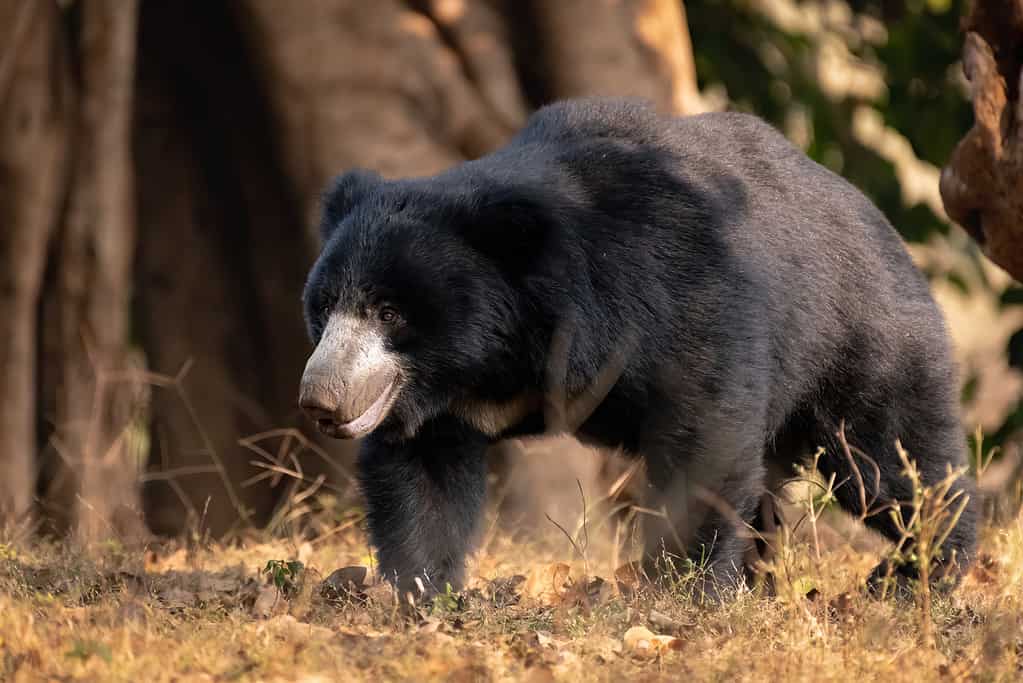
Sloth bears have excellent noses to help them find termites and ants buried in the dirt or under rocks.
©Malcolm/iStock via Getty Images
Baloo is a fun-loving, free animal who wishes for nothing more than the bare necessities and space to relax. This is not too far off from what actual sloth bears do in the wild.
Melursus ursinus, sloth bears live across South Asia, India, Nepal, and Sri Lanka. They love roaming around grasslands, savannas, and wet forests while foraging for food.
Solitary by nature, they do not hibernate like other bears. Instead, sloth bears make nests from broken trees or find empty caves to rest while enduring the cold weather. They are exceptional climbers and very vocal, capable of barking, roaring, snarling, woofing, whimpering, and humming.
Movies depict Baloo as a large bear, often towering over other animals like a grizzly or brown bear. On the contrary, sloth bears are not that tall, being two to three feet high on all fours and weighing 121 to 319 pounds. They feed on termites, ants, fruit, honey, and assorted plant matter. With a healthy diet, sloth bears can live for 40 years.
Sloth bears are vulnerable due to habitat loss from overgrazing and encroachment of human settlements, agriculture, and roads.
Kaa – Indian Rock Python
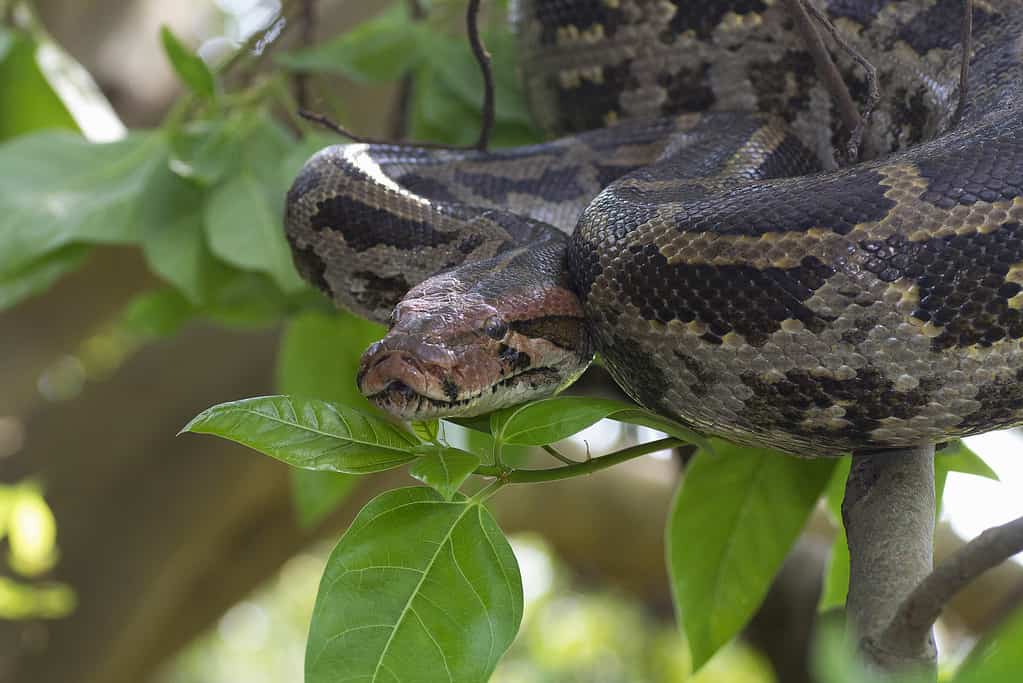
Large pythons avoid trying to eat humans knowing they put up a difficult struggle, but outdoor pets like dogs or cats are susceptible prey.
©ePhotocorp/iStock via Getty Images
Often depicted as a secondary antagonist in films, Kaa is a large boa constrictor attempting to eat Mowgli for a brief section of the movie. However, the stories always show Kaa as a third mentor to Mowgli, offering him sage-like advice while having lived for hundreds of years and being the size of a Titanoboa.
The real version of Kaa is a Python molurus or an Indian rock python. These pythons are nowhere near as large as movies or novels portray the real Kaa to be, only reaching 10 feet long and weighing 301 pounds. Indian rock pythons live for approximately 20 years and avoid humans whenever possible to find easier prey.
These pythons live across Asia, India, Nepal, Pakistan, Bhutan, Sri Lanka, Bangladesh, and Myanmar. They are excellent climbers, capable of slithering up trees and resting on branches, but they prefer to be on the ground where they can blend in with forest floors and mangrove leaves. If necessary, they are considerable swimmers with their scales blending into the dark water. Indian rocky pythons feed on small mammals, birds, amphibians, and other reptiles.
Like many animals in the region, these pythons are near threatened because of habitat loss, illegal trading for pet shops, poaching for their hide, killed for food, or general persecution against snakes.
Shere Khan – Bengal Tiger
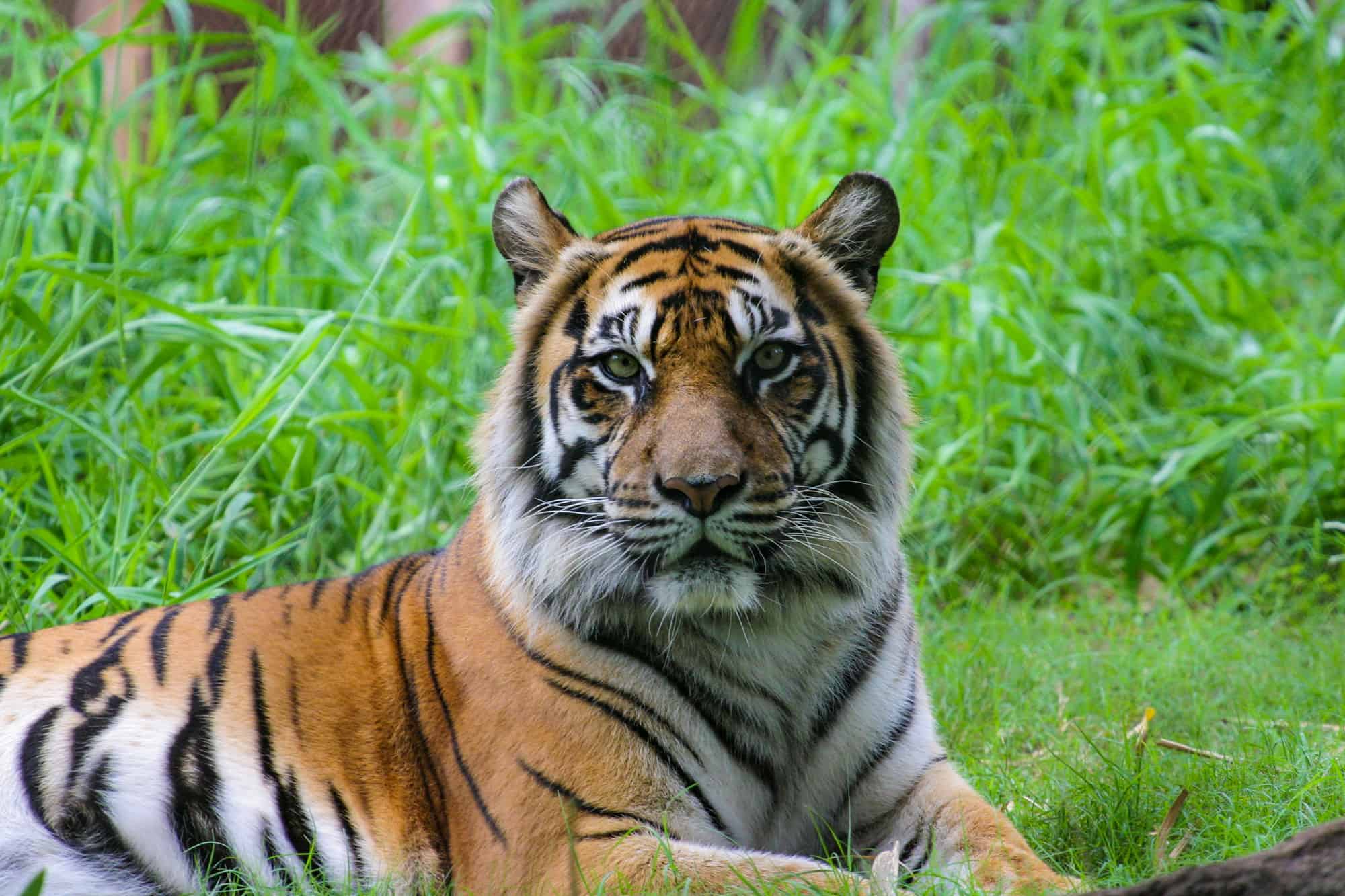
Bengal tigers are larger and heavier than lions, making them a better contender for the title of king of the jungle.
©iStock.com/Henris94
The infamous antagonist in the movies and books, the tiger called Shere Khan plays on the stereotype of a rogue, man-eating tiger out to kill humans.
Panthera tigris tigris, the Bengal tiger is one of the most iconic big cats in nature. Their orange and black coloring is radiant with the black stripes serving to mesmerize onlookers while allowing the tiger to blend into its environment. Weighing up to 570 pounds and reaching nearly 3.5 feet tall on all four limbs, they are capable of living 10-15 years.
Specifically, the Bengal tiger lives in Asia, India, Pakistan, Nepal, Bangladesh, Bhutan, and China. Using its genetic markings, it blends in mangroves, forests, grasslands, and savannahs to stalk its prey and sink its large fangs into their neck for an instant kill.
Bengal tigers are solitary animals and patrol their large territory for food. In territory disputes, tigers will try to intimidate each other to back away, avoiding a fight if possible. Because of habitat loss, some tigers will share territory, on the condition the lesser male is not too close.
Being an apex predator, Bengal tigers will feed on gaurs, water buffalo, boar, deer, langurs, sloth bears, mugger crocodiles, leopards, and peafowl. It is extremely rare for a tiger to actively hunt humans, but incidents have happened in the past.
Unfortunately, Bengal tigers are endangered due to the aforementioned habitat loss and high price for poaching.
Bandar-Log – Gray Langur
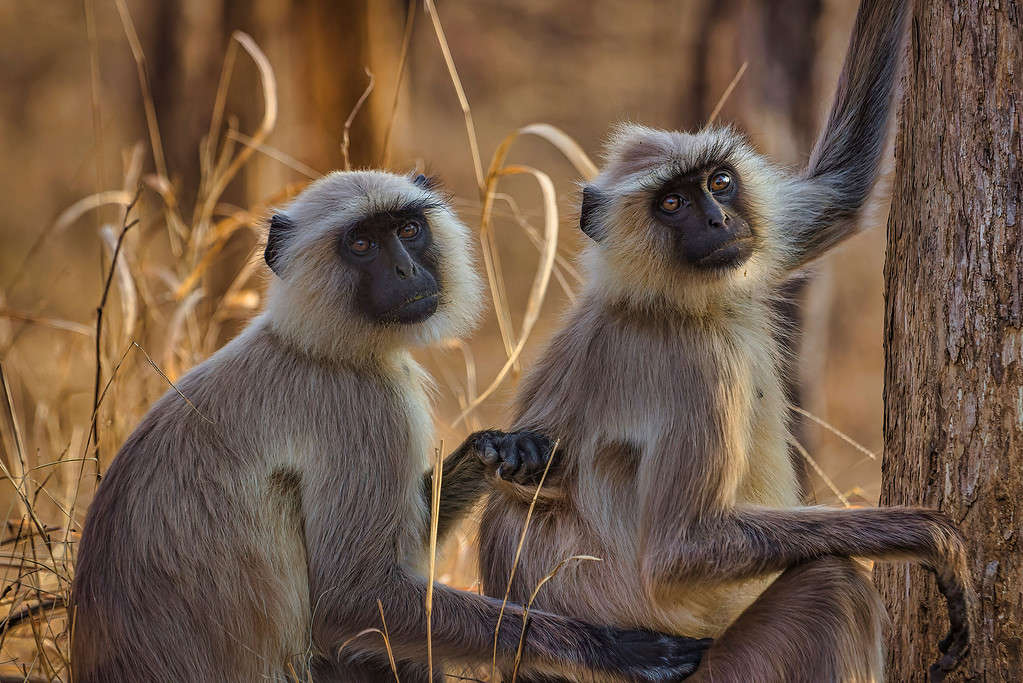
Bandar-log are depicted in movies as different types of langur and other primates living in the region.
©Wirestock/iStock via Getty Images
Technically, Bandar-log are not real animals. The books illustrate how wolves, bears, panthers, and assorted animals live following jungle law. The Bandar-log were primates who did not follow any laws, choosing to live in chaos and anarchy. Incidentally, the movies created the fictional character King Louie a ruler for the Bandar-log, despite it going against their supposed nature to have a ruler.
The real-life equivalent to Bandar-log are Semnopithecus, or the Indian gray langur. Also known as the Hanuman langur, these monkeys live 18-30 years and weigh 35-40 pounds. They are a select species classified as “Old World Monkeys” signified by when they were discovered. Old World Monkeys were monkeys discovered before the voyage and discovery to the New World.
Indian gray langurs live in treetops and abandoned temples across Asia, India, Bhutan, and Nepal. They live in troops of 6-19 members, with some having larger troops in different regions. Langurs work together to forage for leaves, coniferous leaves, cones, fruits, roots, and bamboo to feed. On occasion, they swarm farms to steal crops or wait for humans to hand them free food.
Indian gray langurs are threatened because of habitat loss, car collisions, and persecution for attacking farms.
Hathi and Hathi Jr. – Indian Elephants

Indian
elephants
fan themselves with their long ears to keep cool on humid days.
©Nuttaya Maneekhot/Shutterstock.com
Finally, are the sacred keepers of jungle law and the wisest animals portrayed in most media and books. Hathi and his son Junior are Elephas maximus indicus or Indian elephants.
Indian elephants are highly intelligent animals, living nearly 70 years and weighing 2-5 tons each. They are a subspecies of the Asian elephant but are slightly smaller in comparison. The Indian elephant lives across the Southern and Eastern parts of Asia, Bangladesh, Bhutan, Cambodia, China, India, and Nepal.
Like all elephants, they are megaherbivores, feasting on grass, bark, roots, leaves, vines, shrubs, bananas, rice, sugar cane, and crops. They live in matriarchal groups of 20 related females, with the leader being the oldest. They travel together foraging for food while communicating in honks, bellows, and low-frequency sounds only elephants can hear.
Indian elephants are endangered because of habitat loss, poaching for male tusks, and persecution for damaging crops while searching for food.
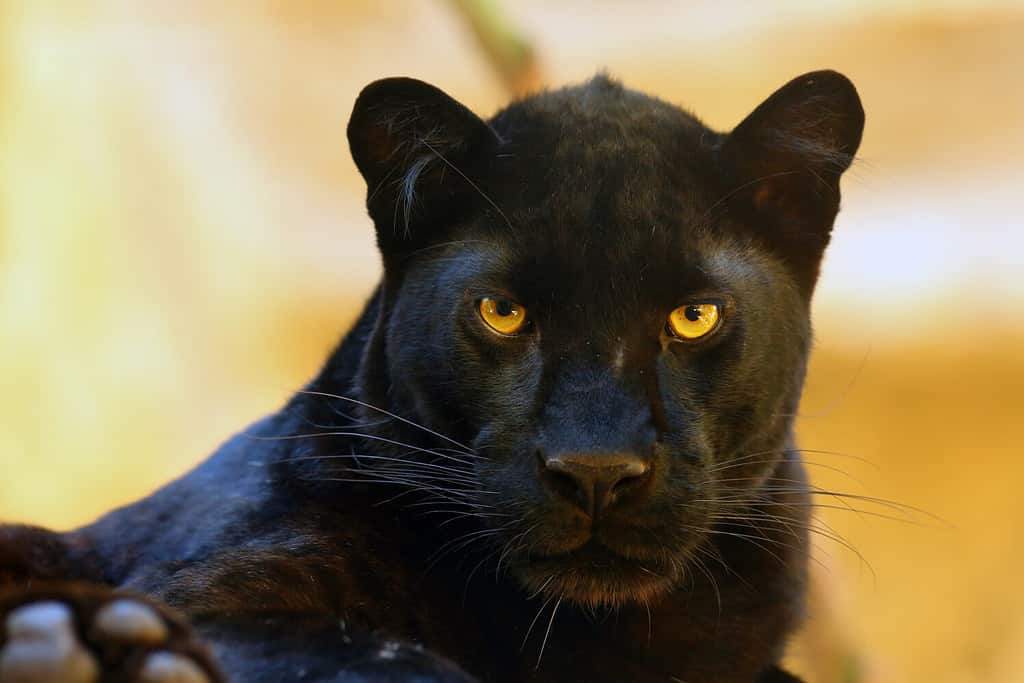
Leopards are commonly called panthers because of their taxonomy “panthera.”
©Karel Bartik/Shutterstock.com
Overall, the movies do a decent job highlighting animals native to the region and keeping the themes of the books intact. Knowing what real-world animals exist in the area makes the books feel more alive and real, seeing many may interact with one another at one point in their life. It may not be like the fables, but more knowledge is never a bad thing to have.
The photo featured at the top of this post is © Ewan Chesser/Shutterstock.com
Thank you for reading! Have some feedback for us? Contact the AZ Animals editorial team.






